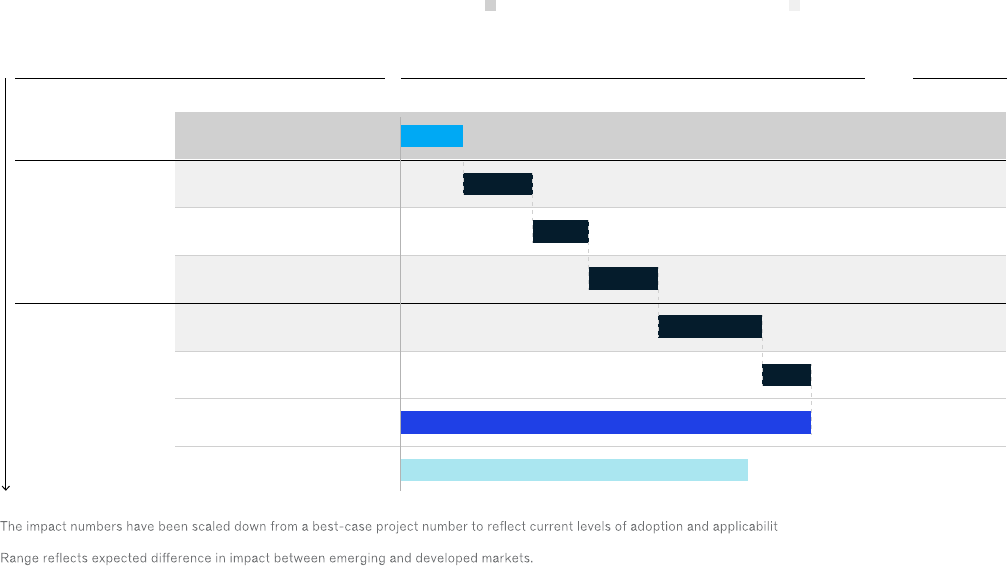
Capital Projects & Infrastructure Practice
Collaborative contracting:
Moving from pilot to
scale-up
Despite the early successes of collaborative-contract adopters, the industry
remains hesitant. Five steps can help project owners better envision the
transition toward more collaborative approaches.
January 2020
by Jim Banaszak, Je Billows, Rudi Blankestijn, Matthieu Dussud, and Rebecka Pritchard
© Getty Images

There is mounting evidence that owners of large
capital projects should consider alternatives to
traditional, adversarial contracting practices. More
collaborative agreements and operating models
can be found in integrated project delivery (IPD) or
project alliancing. Under such models, key delivery
partners (usually the owner, engineer or architect,
major equipment manufacturers, and contractors)
work together during a defined preplanning
period to develop the project scope, schedule, and
budget. These partners form a single contract
including a no-fault clause; and operate under a
joint management structure that governs the project
execution.
Early adopters of these collaborative contracts
in industries such as oil and gas, healthcare,
water, and consumer-packaged goods are seeing
improved financial performance for their capital
projects during execution. Our analysis of eight
collaborative-contract pilots reveals that these
agreements have resulted in a 15 to 20 percent
improvement in cost and schedule performance
compared with traditional contracts (Exhibit 1).
Despite success in the relatively small number of
implementations to date, project stakeholders
have not widely adopted collaborative contracts.
Many willing industry participants stumble because
they are unfamiliar with what it takes to implement
collaborative models or have difficulties finding the
right partners who agree to this type of structure. In
addition, financing parties often hesitate to approve
anything other than fixed-price agreements,
citing uncertainty and an inability to transfer risk.
Moreover, some public-sector owners are legally
required to award contracts to the lowest qualified
bidder, preventing them from entering into more-
collaborative contract terms.
The result is an inability to shake the status quo—an
adversarial contracting practice in which parties
rush through fixed-price contract negotiations,
opening the door for purposely understated
timelines, long delays, and massive budget overruns.
To break old habits and adopt more-collaborative
contracts, our analysis shows that project owners
must start by fully understanding the elements of a
collaborative contract and the spectrum of possible
collaboration. Then they should assess their own
readiness for collaboration, select the right partners,
and invest, as early as possible in the process, in
building out a detailed project description and
0
0 6 8 10 12 14 16 18 20 22 24 26 28 30 32 34
5.0
10.0
2.5
7.5
12.5
15.0
20.0
25.0
30.0
17.5
22.5
27.5
32.5
35.0
McK CP&I 2020
Collaborative contracting
Exhibit 1 of 3
Early adopters of collaborative contracts are seeing improvements in performance.
Improvements to cost and schedule performance realized in collaborative contracts
Improvement in cost performance, % over conventional
Average performance of early adoptersType of projects
Oil eld
Oshore oil
IndustrialHospital
Average
Hospital system
Oshore oil
Channel deepening
Health system
Improvement in schedule performance, % over conventional
Exhibit 1
Early adopters of collaborative contracts are seeing improvements in performance.
2 Collaborative contracting: Moving from pilot to scale-up
aligning critical partners’ incentives. Finally, owners
can integrate best practices—from a project’s start
through its completion.
The elements of collaborative contracts
A fully collaborative contract, such as those found
in IPD, is founded upon cocreation of the project’s
scope of work, transparency, and joint governance.
These elements translate into four major practices:
partners working together during a defined
preplanning period, a single contract among all key
partners, a no-fault clause, and a joint management
structure.
Defined preplanning period
At the inception of any collaborative-contracting
process, the owner starts by selecting all
critical delivery partners, including an engineer
and architect, the main original equipment
manufacturers (OEMs), and at least one contractor.
This core team then works closely—usually at the
owner’s expense—on a conceptual design, cost
estimate, and schedule. It then negotiates and
finalizes the commercial terms of the contract that
link everyone’s interests through the project’s
completion.
Single contract among all critical delivery
partners
The single and final agreement, signed by all
parties, clearly defines the scope of work, schedule,
coordination guidelines, and the collective
obligations of the partners and by exception
the separate obligations of each partner. It also
defines compensation (actual cost and overhead
recovery) and the profit sharing if the project is
successful. In addition, it outlines detailed voting
rights, representation on the governance board and
execution leadership team, and the change-order
process for the project. (Investing in detailed project
definition during the pre-planning period reduces
the risks of change orders.)
No-fault clause
Most often, collaborative contracts include a
no-fault clause that requires members to forfeit
rights to claim against one another. In contrast to
a traditional lump-sum contract, in which owners
attempt to transfer as much risk as possible to other
parties, the partners within a collaborative contract
have a limited ability to submit claims when they
occur. Instead, all project-related decisions are
binding and made by the governance board.
Joint management structure
During execution, collaborative projects are
typically governed by a joint management
structure or regularly convened board with an
explicit contractual obligation for all parties to
make decisions in the project’s best interest. The
governance board consists of a representative
for each critical delivery partner, and each
representative has a vote in every decision related
to the project. All partners commit to transparency
of their own cost and schedule data, and all parties
share the risk and reward of the project outcome.
Choosing a level of collaboration
We realize some project owners may face
constraints on how they’re able to structure
their agreements. For example, owners run
into procurement constraints, strict lending
requirements, government restrictions, or generally
opposed mind-sets and behaviors. These obstacles,
however, should not stop owners from making
progress on initiatives that would facilitate better
collaboration, such as establishing shared digital
information, tailored incentives, and an integrated
design environment.
The level of cooperation in a collaborative contract
can be considered along a continuum, with IPD at
one end as the most collaborative and limited risk-
sharing programs or thematic collaboration at the
other (Exhibit 2). (For examples of collaboration, see
sidebar, “Case examples: Incorporating elements of
collaboration into traditional contracts.”)
Implementing a collaborative contract
Transitioning from a transactional approach to
a collaborative model is no easy task. Certain
situations may not be conducive to full collaboration,
some organizations may not be ready, and with
3Collaborative contracting: Moving from pilot to scale-up

Case examples: Incorporating elements of collaboration into traditional contracts
If the most collaborative agreements can’t be implemented, it is often possible to incorporate specic pieces of collaboration into a
traditional project structure. Below are two examples of project owners that benetted from implementing some collaborative practices.
Intermediate level of collaboration
One self-funded high-technology equipment manufacturer needed to expand capacity but had not built a new facility in more than 20
years. Given the degree of sophistication of the required equipment and original, browneld layout of the facility, initial project estimates
were more than 50 percent above the estimated cost limit to make the business plan work. To make the project nancially viable, the
manufacturer set up an integrated team of designers at a single location: OEMs; engineering, procurement, and construction (EPC) com-
panies; and major subcontractors. This team used a common data environment and design tools, combined with agile working process-
es, to quickly evaluate more than 70 design concepts. Ultimately, the team landed on a concept that would relocate the facility next to
underutilized existing space, signicantly reducing construction complexity. Under separate contracts with shared milestone incentives,
the team completed the detailed design and successfully executed the project.
Low-level (thematic) collaboration
Sometimes adding just one or two pieces of collaboration is both possible and benecial. An oil and gas company, for example, recently
undertook a self-funded, midsize project for which it signed a long-term reimbursable agreement with an EPC contractor. In this agree-
ment, the company and the contractor collaborated on digital transformation and project-data transparency. In return, the EPC con-
tractor was guaranteed a minimum of three projects over the next four years and earned incentives based on overall project outcomes,
including cost and schedule. This arrangement is similar to a typical “open-book estimate” concept and traditional alliance contract. But
unlike most open-book projects where transparency ends after a project is 30 or 50 percent complete, in this case the books stay open
through the end of the project. As a result, most of the risks stay with the client, but it allows for both full transparency on engineering and
construction costs and guaranteed work for the EPC.
Sidebar
McK CP&I 2020
Collaborative contracting
Exhibit 2 of 3
A range of collaboration options is available to project stakeholders.
Transactional Type or degree of collaboration Description
Traditional two-party contracts
1. Thematic collaboration
eg, digital platforms, data transparency,
and shared services
2. Multiparty contract
ie, all key project participants as signatories
one’s performance
—Contracts require a mature or capable contractor market
Project participants agree to collaborate around specic, well-dened
themes or approaches to deliver project more eciently
All major partners shape project scope, validate cost and schedule
estimates, and share risk and prots
—Owner needs to assess its own structural readiness for collaboration,
Area of opportunity
—To succeed, thematic collaboration requires a clear business case
for each eciency improvement initiative
invest in detailed project denition, select the right partners up
front, align incentives of all partners, and relentlessly invest in trust
and collaborative mind-sets and behaviors
Exhibit 2
A range of collaboration options is available to project stakeholders.
4 Collaborative contracting: Moving from pilot to scale-up

collaboration come real challenges (such as
ambiguous roles). Five steps can help project
owners transition to a collaborative model more
easily.
Assess structural readiness for collaboration
Project owners, as the driving force, must
understand their own structural readiness to
implement a realistic level of collaboration. We
have identified a few essential determinants for
owners to assess their readiness for collaborative
contracting:
— Sophisticated contracting and procurement
capabilities, an existing ecosystem of reliable
engineering and construction (E&C) partners,
and limited regulatory constraints on tender
processes
— Strong organizational capacity and capabilities
(such as for enforcing strict stage gates) and
buy-in across the organization, from executive
leadership to the project team
— Progressive risk-management philosophy, as
well as a willingness to invest up front and take
downside risk (after profit of all partners is
forfeited)
— Agile project culture
— Project portfolio with sufficient volume to
support long-term agreements and flexible
financing arrangements
By knowing where their strengths and
weaknesses lie, owners can better select the
appropriate level of collaboration for their
organization.
Select the right partners up front
An owner assessing potential partners must
first ensure the basics, such as that they have
the right qualifications and expertise. Partners
need relevant experience (such as having
designed similar facilities or local knowledge and
presence), distinct capabilities (so that no two
partners overlap), and general financial health.
Next, assessing the openness, self-orientation,
and support for collaboration among a potential
partner’s project team and senior management is
paramount.
In the end, whether the people are a good
fit is what guarantees trust and a healthy
collective decision-making process. During a
Global Infrastructure Initiative roundtable in
Houston,¹ one oil and gas executive concluded,
“Relationships are what moves the needle.”
Further, owners should be prepared for some of
their potential partners to resist the collaborative
process. Our interviews with one early adopter of
lean IPD revealed that 30 percent of its contractor
population was unwilling to entertain the model
when it was first suggested. Undeterred and
determined to embark on an IPD journey, that
owner selected—and continues to select—
partners willing to work within the boundaries of
collaborative structures.
Invest in detailed project definition
When choosing a contract type, project owners
need to decide early if the projected financial
returns and risk profile warrant the cost of a
higher-quality final investment decision (FID). If
so, a cross-functional team—comprising the core
project stakeholders working closely together to
create a detailed project scope, execution plan,
and cost estimate—increases the likelihood of
a sound FID. While this increases the owner’s
financial commitment up front, this investment
is outweighed by the higher likelihood of
successfully executing the project.
One project for a North American transit agency,
for example, involved a large and complex web
of stakeholders. Initially, the agency used a
traditional contract, intending to transfer risk to a
developer. When potential developers evaluated
this plan, none felt comfortable accepting this
level of risk or submitting an offer.
1
“Houston 2019: Using collaboration to improve performance and predictability in oil, gas, and chemical manufacturing project delivery,” Global
Infrastructure Initiative, November 2019, globalinfrastructureinitiative.com.
5Collaborative contracting: Moving from pilot to scale-up

The transit agency had no choice but to adopt a
collaborative model in which each stakeholder—that
is, the agency, developer, and designer—partnered
up to define the scope, craft design solutions,
negotiate right-of-way approvals, and establish a
target cost for the alliance. The agency assumed
the downside risk of delays that extend past a
certain point, but the developer, designer, and key
subcontractors were given incentives to mitigate
any potential overruns. Where a traditional risk-
transfer model was unacceptable to the private
sector, the agency made this project possible
by adopting a collaborative model that better
distributed the risks.
Align incentives of all partners
Distractions and inefficiencies often occur when
each project stakeholder works toward individual
project goals. Setting up a common incentive pool
that grows or shrinks based on overall project
performance (along with all parties distributing pro
rata compensation) is one approach to facilitate
collaboration among project stakeholders.
This approach was successfully used on an offshore
project. Although each party had a separate
contractual relationship, ranging from reimbursable
to lump sum, the partners had the opportunity
to earn additional profit through a gain-share
agreement—if and when the project came in under
budget and ahead of schedule.
Relentlessly invest in trust
Moving from an adversarial to a collaborative
approach requires persistent investment in not
only building and maintaining trust among delivery
partners but also instilling collaborative behaviors
(such as problem solving, knowledge sharing,
curiosity, and creativity). To succeed, project owners
should define their organizational aspirations and
make those as important as a project’s financial or
schedule goals and enforce reliability and openness,
two of the key dimensions of the “trust equation.”²
Then they must measure their progress against
their goals. Relevant performance indicators can
be scores on engagement surveys by project team
members, number of cross-stakeholder problem-
solving sessions, cost or schedule improvement
opportunities cogenerated by the team, or the
number of digital innovations that were made
possible through collaboration.
Formal mechanisms, such as tying senior leaders’
compensation to organizational alignment goals,
should also be implemented to reinforce the desired
mind-set shifts. Leaders need to understand
their role in overcoming decades of negative
conditioning that make it hard for teams, even
willing ones, to embrace collaboration. Habits are
deeply entrenched, so collaborative teams need
training, feedback, and reinforcement not just at the
beginning but throughout the project life cycle.
Each of these steps is critical, but none can
succeed without a few supporting elements. One
is contractual enforcement; in fact, the former
director of capital projects for a consumer-products
company stated, “Contractual reinforcement is
the secret sauce.” Other essential factors involve
rigorous project- and performance-management
science, including a digital control tower and
war room; agile teams that are accountable for
delivering impact; and finally, a joint execution-
leadership team and project-governance board with
clear authority.
No time to waste
When it comes to the transition away from
transactional contracting practices, project
owners do not have the luxury of time. Major
North American E&C companies have already
reconsidered whether they should bid competitively
on lump-sum contracts at all. As more project
stakeholders take the same path, project owners
that stick to traditional contracts may soon be left
with fewer options and rising prices.
Additionally, those that wait to act risk missing out
on the potential benefits of collaborative contracts
for the entire industry—benefits that are exciting
2
McKinsey’s organizational research defines the “trust equation” as trust = (reliability × credibility × openess) / (self-orientation).
3
For the full report, see “Reinventing construction through a productivity revolution,” McKinsey Global Institute, February 2017.
6 Collaborative contracting: Moving from pilot to scale-up

to contemplate (Exhibit 3). A 2017 McKinsey Global
Institute (MGI) report on construction productivity
identified collaborative contracting as one of the
largest opportunities to improve the productivity
of the industry.³ Based on our research, we also
believe that collaborative contracts and practices
serve to enable three of the other levers to improve
productivity: technology adoption, design and
engineering, and on-site execution.
Adoption of digital project tools
Implementing digital tools on projects requires
significant investments in capital, work processes,
and time. E&C contractors and suppliers rarely
make those investments on their own without
knowing that there will be some sort of payoff. That
impediment in the industry would be removed
if project owners proactively invested in digital
infrastructure with a consistent capital program
and a network of committed E&C contractors and
suppliers codeveloping the solution.
Design and engineering
Using a digital design platform is not new to the
industry, but making it transparent and shared
across all parties is a marker of a collaboration. It
creates one source of truth and enables faster
creation of a “digital twin” prior to construction.
When integrated into a database rather than
segregated into distinct disciplinary silos, digital
design deliverables enable more-efficient
cross-party clash detection, along with joint
owner-contractor-supplier design processes and
construction and operability reviews. The results?
Improved engineering quality and accelerated
design releases for construction.
McK CP&I 2020
Collaborative contracting
Exhibit 3 of 3
Collaborative contracts improve project relationships directly and enable productivity
improvements in design, execution, and technology.
Lever
Regulation Enabler
External forces
Industry dynamics
Firm-level
operational factors
Collaboration and contracting
Design and engineering
Procurement and supply-chain
management
On-site execution
Technology
Capability building
Cumulative impact
Gap to total economy
productivity
Global levers to improve construction productivity
Potential global productivity improvement from implementation
of best practices,¹ impact on productivity, %²
Cost savings,
%
7–10
6–7
3–5
4–5
4–6
3–5
27–38
8–9
8–10
7–8
6–10
14–15
50
5–7
48–60
Enabled by collaborative contractsDirectly improved by collaborative contracts
1
y across projects, based on survey
respondents who responded “agree” or “strongly agree” to the questions about implementation of the solutions.
²
Source: McKinsey Global Institute Construction Productivity Survey, n = 210
Exhibit 3
Collaborative contracts improve project relationships directly and enable productivity
improvements in design, execution, and technology.
7Collaborative contracting: Moving from pilot to scale-up

On-site execution
A single source of truth for design, supplier,
and project-management data addresses the
communication gap typically seen between
home-office and on-site teams. This facilitates the
on-time structuring of data into construction work
packages, which improves construction readiness
and enables implementation of advanced
production or construction planning tools.
Furthermore, when teams work in the same place
and from the same project-controls systems
and dataset, it accelerates the on-time release
of forward-looking, actionable data needed
to proactively manage a project. That’s a stark
contrast from traditional structures, in which
project controls gather data from multiple parties,
and typical project-reporting cycles result in data
that’s at least three weeks old—too late for project
leadership to make effective adjustments when
needed.
The value at stake for project owners is enormous.
If just half of the 15 to 20 percent improvement
realized on initial collaborative contracts can be
sustainably achieved, project owners could save
$5 trillion to $7 trillion of the $77 trillion that MGI
believes will be spent on capital projects over the
next ten years. With industry participants becoming
increasingly frustrated with the status quo, now
is the time to make collaborative contracts the
norm and thereby reinvent the owner-contractor
relationship—and the construction industry along
with it.
Copyright © 2020 McKinsey & Company. All rights reserved.
Jim Banaszak is a partner in McKinsey’s Chicago office, Jeff Billows is an expert in the Dallas office, Rudi Blankestijn is a vice
president of CP&I major projects in the Houston office, Matthieu Dussud is an associate partner in the Toronto office, and
Rebecka Pritchard is a specialist in the Atlanta office.
The authors wish to thank Phillip Bernstein, Mark Kuvshinikov, Thibaut Larrat, Peter Trueman, and Homayoun Zarrinkoub for
their contributions to this article.
8 Collaborative contracting: Moving from pilot to scale-up
